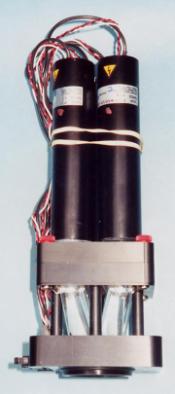IRIS4 QUAD PHOTON COUNTING MULTIBAND DETECTOR


Quartz and feldspars emit TL and OSL in a number of bands corresponding
to different trap depths, each with its own kinetics. For many years,
there has been a search for the 'right' combination of filters for selecting
the 'best' detection band in order to produce reliable luminescence dates.
By ignoring other bands, or by mixing them, information is lost.
A new multi-detector has been designed to take advantage of now-available
low cost, compact, integrated photon counters. The detectors we use
have UV glass windows and bialkali photocathodes with a darkcount under
25 cts/sec. We have incorported four of these with UV quartz light
guides (not fibers) to measure TL/OSL in four filter determined bands.
The input end of the light guides form a dome over the sample for excellent
coupling efficiency. The geometry is as efficient as that of a 50mm
PMT, though since each detector looks at 25 per cent of the input aperture,
the multiplex advantage of a grating spectrometer is lost. However,
the average grating efficiency over its wavelength range is less than 30
per cent, and of course, an input slit makes efficient coupling impossible.
So, overall, throughput of the filter detector system is quite high, high
enough for routine work with most geological materials. The unit
is 96 mm square by 260 mm high, and mounts on all Daybreak instruments
with the quickchange scheme. The TLAPPLIC software package is being
updated to allow multiband data acquisition and reduction. Up to
12mm of filter can be accommodated in the holders, usually a combination
of interference and optical glass filters. The four-channel counter
pod is in the cable connecting the IRIS4 to the expansion adapter of the
1100- and 2200-series instruments. The detectors are enabled separately
under software control, so that detectors with filters transmitting an
OSL stimulation wavelength may be protected.
The IRIS4 is really nothing more than the old idea of a rotating filter
wheel, but with no moving parts, and the possibility of swapping in detectors
with other photocathodes, such as red-sensitive PMTs. Though hardly as
sexy as a grating-based instrument, the advantages of cost and efficiency
(for small numbers of detection bands) make this brute-force multidetector
approach the best choice for dating, as opposed to characterization of
artificially irradiated minerals.
A red sensitive adapter using a room temperature reflective mode photocathode
side window is planned. This PMT has useful response to 700 nm PMT (less
than 25 cts/sec selection available). It may substitute for one of
the four detectors in the IRIS4. This adapter will sit atop the IRIS4
case like a hat.
This is the first of a planned family of multiband detectors.
We have designed very compact 16- and 32-channel photon counting grating
spectrometers using multi-anode PMTs, and will bring them to production
when sufficient interest makes the effort worthwhile. The price is
expected to be extremely reasonable, especially when compared to such instruments
using position-sensitive PMTs.

